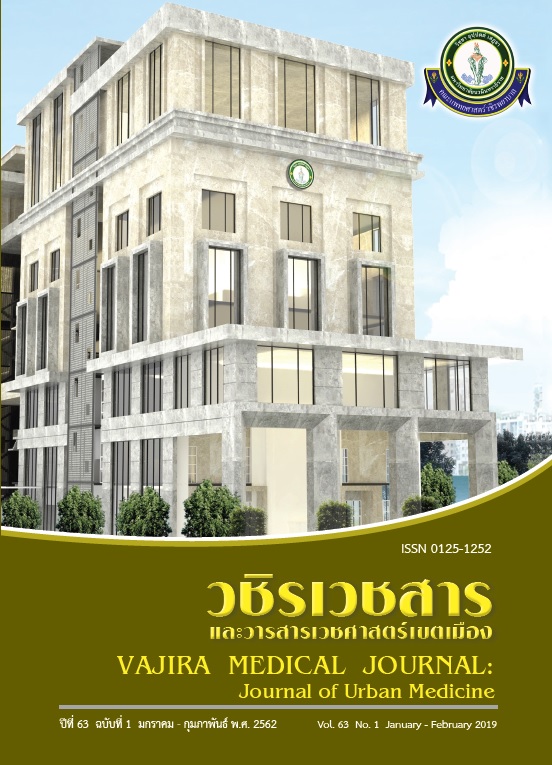Prevalence of Thalassemia and Hemoglobinopathyin the Users of Thalassemia Screening Service at Queen Savang Vadhana Memorial Hospital, The Thai Red Cross Society
Main Article Content
Abstract
Objective: of the descriptive research is to study prevalence of Thalassemia and Hemoglobinopathy in the users of Thalassemia screening service at Queen Savang Vadhana Memorial Hospital.
Methods: The Thai Red Cross Society. InThalassemia and Hemoglobinopathy screening, CBC, OF, DCIP, and α-thalassemia IC strip test were used to examine and separate for analysis of types of Hemoglobin with Cellulose acetate electrophoresis and HPLC The size of samples was calculated from prevalence of the latest research where prevalence of Thalassemia in the users of Thalassemia screening service was detected in the rate of 35.89% using formula of n = z2 ' p ' ´(1-p)/d 2. At least 181 persons were acquired as the size of samples. The sample group in this research was all users of Thalassemiascreeningservicein 2016.
Results: The finding of studying results Prevalence of thalassemia carriers Hemoglobin E, 29.2% and EE homocysts, hemoglobin E 23, 3.9%, hemoglobin carriers, EE / EF, 2.2% and alpha-thalassemia carriers 0.2 . The finding from screening of -thalassemia carrier with
-thalassemia IC strip test indicated positive results for 63.2%. Hb typing was conducted with Cellulose acetate electrophoresis Method and confirmed with HPLC Method. In suspicious cases, the finding indicated abnormal results or being Thalassemia diseased for 38.8% consisting of Betathalassemiadiseased for 35.2% and Alpha-thalassemia for 3.6%.
Conclusion : Prevalence of thalassemia And hemoglobin disorders by screening. CBC, OF, DCIP, - thalassemia IC strip test and hemoglobin assay using cellulose acetate electrophoresis and HPLC to guide volunteers. Thalassemia carriers were counseled to plan their family and reduce the incidence of thalassemia in the future.
Downloads
Article Details
References
2. Sathian Suksananan. Diagnosis of thalassemia carrier Bangkok: The Thalassemia Foundation of Thailand.Available at: https://www.thalassemia.or.th/thaiversion/carrier-th.htm. Retrieved April 7, 2013.
3. Fucharoen S, Winichagoon P. Thalassemia in Southeast Asia: problem and strategy for prevention and control. Southeast Asian J Trop Med Public Health 1992; 23: 647-55.
4. Uravan Surin et al., Thalassemia and Iron Deficiency in Positive Population of OF Test and KKU-DCIPC lear. Journal of Hematology and Transfusion Medicine 1997; 2: 111-8.
5. Ampaipan Juansamrit. A comparison between Thalassemia Screening Test and Hb Typing. Journal of Hematology and Transfusion Medicine 1997; 9: 49-52.
6. วิลาวัลย์ ปาลี.อุบัติการณ์พาหะธาลัสซีเมียในการตรวจคัดกรองคู่สามีภรรยาที่มาฝากครรภ์ โรงพยาบาลสันกำแพง จังหวัดเชียงใหม่. 2551.
7. สนั่น ชื่นตา. อุบัติการณ์พาหะเบต้าธาลัสซีเมีย โรคธาลัสซีเมียและฮีโมโกลบินผิดปกติในโรงพยาบาลยโสธร. ยโสธรเวชสาร. 2542
8. Pharephan S, Sirivatanapa P, Makonkawkeyoon S, Tunitwechapikul W, Makonkawkeyoon L. Prevalence of α-thalassaemia genotype in pregnant women in northern Thailand. Indian J Med Res. 2016; 143: 315-22.
9. Khomsan yooyen. Cut off MCV and MCH Appropriate for screening α–thalassemia and b–thalassemia: Information from 4 community hospitals in the Northeast. Journal of Medical Technology and Physical Therapy 2011; 2: 28-37.
10. กรวัฒน์ สีใส, จักรพันธุ์ รุณเจริญ, จินตนา ศิริวารินทร์, พงศธร ชาญเนตร. การศึกษาพาหะของแอลฟ่าธาลัสซีเมียโดยเทคนิค Multiplex PCR ในหมู่บ้านตำแย อำเภอม่วงสามสิบ จังหวัดอุบลราชธานี. คณะเทคนิคการแพทย์มหาวิทยาลัยรังสิต. 2554.


